
Did you know that since 2023, 302 hydrants have gone missing in Los Angeles County, some 100 hydrants stolen in 2024 alone? Because it costs between $3,500 and $4,000 to replace a stolen hydrant, the thefts have translated into a loss of $1.2 million to the company that manages the hydrants, Golden State Water Company.
Kidding about the zombies.
Our first question upon reading about this issue was: How on earth does one steal a fire hydrant?
We learned that the first step is to either unscrew the bolts that attach the hydrant to its base, use power tools to remove the hydrant, or just knock it over with a vehicle, though latter strategy leaves water shooting out of the uncovered opening. Most thieves know to use a shutoff valve to stop the water flow. After that, however, it’s off they go.
Many of you might ask a different question: Why? Why steal a fire hydrant?
As a rule, stolen hydrants are taken to recycling centers where they’re broken down and sold for scrap metal. The brass in the hydrants is especially in demand.
To combat this growing problem, Golden State Water company has installed locked shields that cover the fire hydrant’s bolts making them harder to steal (it’s hoped). Aside from the fact that tampering with a fire hydrant is a federal offense, its flat out dangerous for obvious reasons. The best time to conquer a fire, particularly a house fire, is within the first five to 10 minutes when damage is still minimal. After 15 minutes, a fire grows almost exponentially and every second is critical. Without quick access to a fire hydrant, the delay in finding a water source can quite literally cost lives.
The connection between fire hydrants and dogs is classic. Dogs are instinctively drawn to fire hydrants as they are ideal vertical objects on which to mark the dog’s territory. They are especially appealing if a dog can obliterate the scent of dogs that have come before, a chance to assert their own presence and dominance in the area. This is so important that tiny breeds have been known to stand on their two front legs to make sure their urine is “distributed” high up on a hydrant.
Why is height important? When a small dog urinates higher up, it can help them “erase” the scent left by larger dogs. It’s a signal to those larger dogs that an assertive “bad ass” dog unlikely to be pushed around was the last to urinate on the hydrant, even though the dog may have been a Chihuahua. Remember, now, that marking with urine conveys information about a dog’s status, health, identity, and yes, size.
But there is another reason dogs are attracted to hydrants. Most are red! Some veterinarians believe the reason behind dogs urinating on red fire hydrants is due to sweet smelling dyes used to paint them (and did you know that some municipalities allow you to paint a fire hydrants? It’s a common misconception that fire hydrants have to be red when in fact, there are no specific color requirements for hydrants, they just have to be painted any color that’s is visible and in contrast with its surroundings, but not purple because a purple fire hydrant means that it is a private fire hydrant and should only be used by the owner). That said, we learned that fire hydrant colors mean something and are important for firefighters because (and depending on the set of guidelines being followed), the color lets the fire department know how much water is available for them to use. You can read more about that here.
And speaking of festive fire hydrants, if you go to Farmland in Randolph County, Indiana, and drive half a mile from the junction with Jackson Street, you’ll spot a “Dalmatian Fire Hydrant.” Novel as it is to paint a hydrant to resemble a Dalmatian, it’s not all that novel, and an internet image search on “Dalmatian Fire Hydrants” will bring up hundreds of results. What is novel among them is the hydrant in Beaumont, Texas. The 24-foot-tall white and black-spotted fire hydrant that can blast 1,500 gallons of water a minute is the world’s largest working fire hydrant, this according to the World Record Academy. The hydrant was donated in 1999 by Walt Disney to promote the re-release of “101 Dalmatians.”
We did come across another hydrants painted like a Bulldog, but most hydrants painted to look like a dog pick a Dalmatian. Why?
Little doubt that it has to do with the breed’s association with fire stations, and a time when fire trucks were drawn by horses accompanied by coach dogs, namely, Dalmatians.
As an aside, did you know that fire hydrants got their start in the 1880’s when city waterworks hollowed out cypress logs, filled them with water, and buried them underground like the modern day piping system? To get the water out, firemen dug down to the log, drilled a hole, and filled the engines with the water. When they were done, they plugged the hole to save the rest of the water – and this is where the term, “fire plug,” comes from.
Do you feel like you now know more about fire hydrants than you wanted to?
Image: Bulldogs with hydrant by willeecole/Depositphotos
